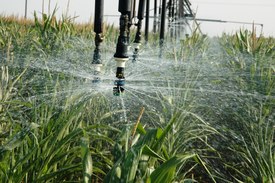There are many 'users' of water: agriculture, industries, energy, public supply, transport and leisure. For most uses, we extract water from a source, use it and release a part of it back to a water body such as a river or a lake. The water we return to nature often has adifferent quality than the water we abstracted.
Changes to a water body – adding polluted or warmer water, or extracting substantial amounts – could affect the entire basin and all the living things, including the people, who depend on that water.
It is clear that our economy and society relies on water. It is also clear that the wellbeing of our natural systems and their functioning and ability to provide us with natural services also depends on their 'access' to the right amount of water resources. We need water and nature needs water.
Parts of Europe are already faced with water scarcity or seasonal droughts. Others experience flush floods. Depending on the region, climate change is also expected to have an impact on the quality and the quantity of Europe's freshwaters. How can we make sure that both nature and the society have access to the amount of water needed, not only today but also tomorrow?
Water and resource efficiency
A sustainable management of Europe's water resources demands a wider policy perspective, addressing all major users as well as water's interactions with other resources, including land and energy. In this respect, Europe's water management needs to be seen in the much broader context of building a low-carbon, green economy.
There are close links between water, energy and food. We need water to grow our food, energy to transport and treat water, water to generate energy, and energy to desalinate water in water-scarce areas. This nexus means that to achieve efficient use of water resources, we have to redesign our energy, transport and agricultural policies as well as our cities.
Agriculture and water
Agriculture accounts for around a third of total water use in Europe. In parts of southern Europe, this share can reach up to 80%. In recent years, improving irrigation, for example by switching from furrows to drip systems, has increased water efficiency but has not always reduced the total amount of water abstracted. For example, in parts of Spain efficiency gains led to a tripling of irrigated area.

There are many measures which could be taken to improve water efficiency in agriculture. For example, crops vary considerably in terms of water requirements and drought resistance. Selecting less water-intensive crops and changing the timing of cultivation could help reduce the need for irrigation.
In water-stressed areas, treated wastewater provides an alternative source of water for irrigated crops. In Gran Canaria, for example, 20 % of water used across all sectors comes from treated wastewater.
Reducing pesticide and fertilizer use would not only improve water quality but also reduce the amount of energy used to treat wastewater.
Photo (c) agrilifetoday | flickr.com
Water and energy
The link between water and energy is quite complex. Hydropower provided 16 % of electricity in Europe and 67 % of all renewable electricity in 2010. Although more than 85 % of hydropower energy is produced by large plants, EU countries plan on setting up a large number of smaller hydropower installations. These can obstruct upstream and downstream migration of fish, change the water flow and sediments, and risk affecting aquatic ecosystems.
Decisions on where and how to install hydropower plants need to be taken case by case at the regional level by assessing environmental impacts. Hydropower should also be assessed against other renewable energies, such as solar and wind.
Desalination is another factor linking energy and water. Some water-scarce regions might resort to desalination to meet their fresh water needs. Europe holds around 10% of the global desalination capacity, led by Spain by a large margin and with 20 new installations planned.
Desalination requires a lot of energy to a point that it could jeopardise the energy reductions planned under the EU's climate and energy package. Moreover, the salt concentration released at the end of the desalination process also has impacts on the environment.
Policy and markets
The European Union's Water Framework Directive, complemented by other EU legislation including the Nitrates Directive and the Urban Waste Water Treatment Directive, provides a solid legal framework to improve the state of Europe’s water bodies.
The European Union’s longer-term resource-efficiency objectives are presented in a flagship initiative under the Europe 2020 strategy. More specifically, water related resource efficiency will be at the heart of the EU's policy recommendations to be presented in the context of the upcoming "Blueprint to safeguard Europe's water".
In addition to long-term goals, there are many opportunities for quick gains, first and foremost, through a better and full implementation of existing legislation, including the Water Framework Directive.
To contribute to good water governance, market and government mechanisms could help foster a pricing system that also reflects the environmental and possible social costs. A more 'appropriate' price would also drive innovation forward.
When supported by awareness campaigns, economic instruments (tariffs, taxes, subsidies, permit schemes and so on), measures against leakage and illegal abstraction, prices could send signals to users strong enough to change consumption levels and patterns.
There is much to gain from policies, efficiency measures and behavior change. To preserve this valuable resource, we have to adopt them all.

Document Actions
Share with others